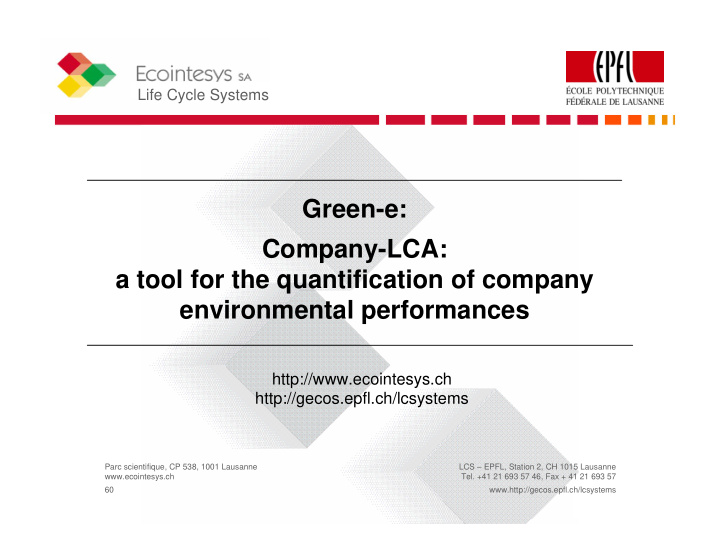



Life Cycle Systems Life Cycle Systems Green-e: Company-LCA: a tool for the quantification of company environmental performances http://www.ecointesys.ch http://gecos.epfl.ch/lcsystems Parc scientifique, CP 538, 1001 Lausanne LCS – EPFL, Station 2, CH 1015 Lausanne www.ecointesys.ch Tel. +41 21 693 57 46, Fax + 41 21 693 57 60 www.http://gecos.epfl.ch/lcsystems Y. Loerincik, November 2005
Environmental efforts: Life Cycle Systems a shift vs. to the impacts! Environmental 100% Effort 80% Impacts 60% 40% 20% 0% 1er trim. 2e trim. 3e trim. 4e trim. Raw Materials Production Use Waste treatement Site Cradle Grave Y. Loerincik, November 2005
Aims Life Cycle Systems 1.How to assess the environmental impacts of a company going beyond on site emission? 2.How to make use of existing LCA databases in a more company oriented decision support tool? 3.How to do so following a clear and reproducible standard approach in a time- efficient way? 4.How to assess the company LC impacts consistently with the life cycle costs? Y. Loerincik, November 2005
Green-e: combination Life Cycle Systems of 4 analysis modules Life cycle thinking Toxic impacts Energy + CO2 Legal Life cycle compliance costings Y. Loerincik, November 2005
Company’s Life Cycle Life Cycle Systems System Upstream Direct Downstream Waste disposal Upstream Company site and recycling emissions direct emissions emissions Company Company processes (B) Suppliers for Company waste (b) company disposal processes (C) (A) Natural resources Natural resources Natural resources consumption consumption consumption Product disposal Upstream Use-phase and recycling emissions Direct emissions emissions Products Suppliers for Products Products products use-phase disposal use-phase (E) (F) (D) Natural resources Natural resources Natural resources consumption consumption consumption Y. Loerincik, November 2005
Pharma Industry Life Cycle Systems Europe Switzerland Europe World R&D Chemical production Pharmaceutical Packaging production Production site Sales/ shipping Worldwide sales unit (representants) Y. Loerincik, November 2005
CO2 Emissions Pharma Life Cycle Systems Industry CO 2 Emissions at different Life Cycle Stages 4 3 kg CO 2 / kg product Sales representants Business travel Products 2 Employees Raw materials Electricity 1 Fossil fuel Secondary packaging 0 production production Packaging inceneration materials Transport Buildings (energy) R&D 6 x the product mass Energy Waste Raw Site 70 x the active substance mass Y. Loerincik, November 2005
Life Cycle Systems Results: Pharma exemple Life cycle primary Energy Balance and related costs 100% R&D (énergie) Sales representants 80% Transport of produits Transport of raw materials Business travel 60% Employees commuting Waste treatement 40% Buildings Packaging Heating 20% Raw materials Electricity 0% Primary CO 2 Costs Energy Emissions Y. Loerincik, November 2005
Pharma: Conclusion Life Cycle Systems • Reductions of impacts have to be considered also outside the classical company boundaries • Decision-makers should realize that a consistent environmental management has to be based on a life cycle perspective • Merging LCA and LCC enables to validate the right correlations Y. Loerincik, November 2005
Originality of the Life Cycle Systems approach Simple and scientifically reliable screening approach Quantified analysis of environmental impacts for Environmental Management Systems Life cycle philosophy: from suppliers to users, through to end of life Flexibility to others environmental evaluation tools like LCA, RA, etc. Links environmental impacts to costs Benchmark to standards and similar sectors of activity Y. Loerincik, November 2005
Recommend
More recommend